I am going to coin a new title for what's going on here with this renewed modern movement. Re-Modern I'm going to call it, re-mod for short.
I have been trying to come to terms recently with my motivations for creating these stock plans. I mean beyond the obvious, yes, I am selling them to expand my business, modern houses because I love modern design. I am trying to come to an understanding of why I want to do this in the context of these plans being an agent of change in the housing marketplace. I won't flatter myself as whatever change they may bring about may be very small, but rather it is something that I am able to do no matter how small it is in the big picture.
I have laid down some thoughts in the course of posting to the message board at LiveModern, but I thought it would be worthwhile to post a narrative of these thoughts as part of my blog so I could pursue the thoughts outside the conversation of a forum.
On this thread we were discussing the cause and meaning of the trend of "tagging" in suburban developments. Whether related or not it brought on this train of thought which I will copy and paste here:
We talk about Modern being a lifestyle right - its not just about collecting nice furniture and having big windows, right? I have been trying to pin down the values that it represents. I think at the core is not kidding yourself about "where" you are - the most obvious manifestation of that value is no phony cutesy historical styles for my home in the here and now.
Now I extrapolate that to somebody who sees no conflict in living in a phony historical home, and what other kind of contradictions are they willing to accept, ignore, or be ignorant of? Where else are they willing to kid themselves?
There is a big leap of thought in that quote which I want to try and think through at a slower pace. I don't believe that I can map clear stepping stones from the postulation to the conclusion, but I do think I can fill in the gaps a bit more.
Where I am coming from is this - that the people coming out of the woodwork these days at LiveModern, at Dwell, at fabprefab, the thousands of people who seem passionate about modern houses, they feel this way not just because a modern house looks cool - it appeals to them, or maybe it looks cool to them because it reflects their values. I mean "reflect" in a quasi-literal way: they look at these modern houses and they see themselves in it, meaning not just they see themselves living in it, they see it as representing the way they want to live their lives. I am going to expand on this in future posts, think about the values this all represents, what is important to this new class of modernists, and maybe you all will help me with it.
Ok thats the first part of my quote. The second is my so called conclusion. I am jumping to conclusions here - like if the lights are on in the house, then it must be dark outside. Well it is a not necessarily true but I've seen it before kind of thing. I am projecting on my observations about the people who could care less about modern design, and for whatever reason have as their life ideal a suburban mcmansion. I am proposing that it is not just simply a harmless status quo, and there is at the very least some virtue to being a modernist that goes above and beyond simply liking good design, but that it is an indicator of more thoughtful or responsible values, values that could stand to make the world a better place to live.
Whew - that is quite a leap, huh? Well, I'll work on it - right here. Whether I can prove it in court or not, it will provide me the inspiration to make more plans!
Past comments:
My thoughts on who modernists are
Posted by Rous at 03-29-2004 11:02 AM
All of this is just IMHO. I am not trying to speak for everyone.
(Re)Modernists are a pretty diverse group. I am sure there are those that like Dwell just because they think the houses are cool. Still, I think most of us would agree with Socrates that "an unexamined life is not worth living." That is, we want to live meaningful lives that are under our control. We don't trust sound bites, 15 second ads, politicians, or corporations much. We don't things should be done a certain way just because "that's the way they have always been done." Now maybe it is a bit of a jump, but I think consistent with the thoughtfulness I have just described, is a disdain for things that are phony. Modernists have an affinity for things that are "true" and authentic and honest. Here is where our love of modern design comes into play. IMHO, one of the tenets of modernism is a simple, honest use of materials.
As for floor plans, I am not sure the open plan is necessary for a house to be modern. However, wanting a house that fits the way we live and not designed to impress the neighbors is a modern concept. Now that the kitchen isn't a place for Mom to make dinner, but a place for family and friends to gather, the kitchen should accommodate that. Life is less formal so the formal living room is unnecessary, but unless you have a basement, the kids are going to need their own living room for their computer, video games, and to get away from Mom and Dad. As for the formal dining room, the space is better used for a home office. But that means the only dining area should be a bit bigger and nicer than just sticking a table in the middle of the kitchen. We also realize our lives are going to change. So the more flexibility is built into the design, the better.
Posted by lavardera at 03-30-2004 09:18 AM
Rous said:
...a disdain for things that are phony. Modernists have an affinity for things that are "true" and authentic and honest.
I agree with this sense that it represents a value of living with truth - as I like to call it "in the here and now", acknowledging the situation you are in. I always want to resist saying that it is a moral issue, but it certainly sounds like it. Well what does that mean anyway: here is the first definition that comes up:
moral
\Mor"al\, a. [F., fr. It. moralis, fr. mos, moris, manner, custom, habit, way of life, conduct.] 1. Relating to duty or obligation; pertaining to those intentions and actions of which right and wrong, virtue and vice, are predicated, or to the rules by which such intentions and actions ought to be directed; relating to the practice, manners, or conduct of men as social beings in relation to each other, as respects right and wrong, so far as they are properly subject to rules.
It sounds more about rules than values. But that does not make sense. If you look at the houses built today you would guess that the rules say that houses must be something that they are not, and people must pursue the latest in technology in their cars and cell phones, but not in the way their houses look. Well, in fact the rules do say that in many instances but that is another argument about deed restrictions. I would like to think that the rules being considered are more of a cultural understanding rather than the ordinances we put ourselves under.
To me it unearths another great contradiction. Just as we build phony old houses and drive modern new cars we make rules that require us to lie?
Technorati Tags: modern design, modern house
Continue reading "roots of this re-modern movement"
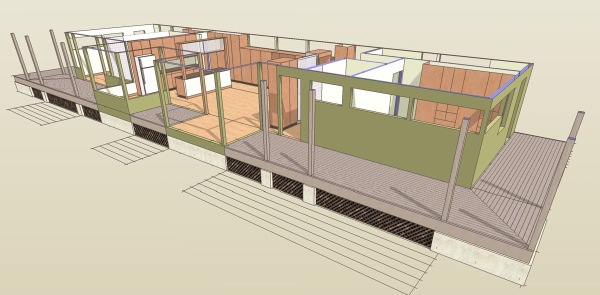

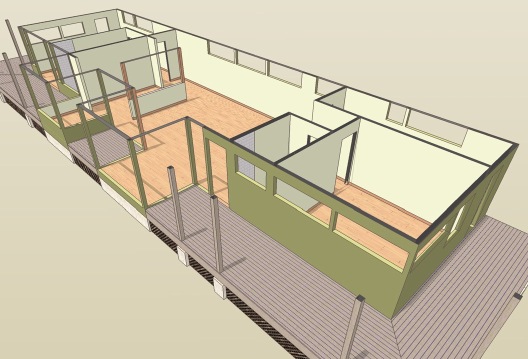
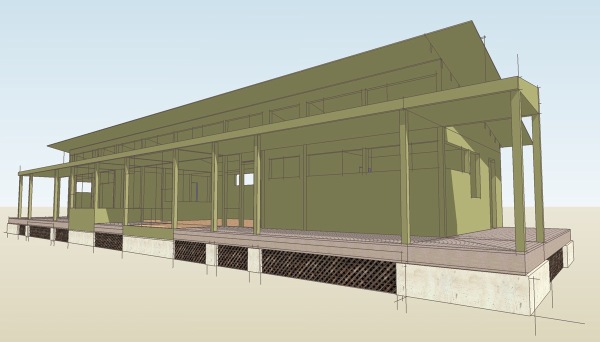
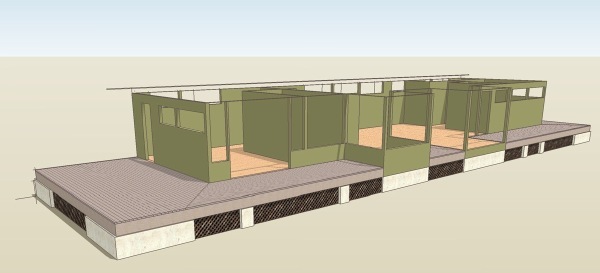
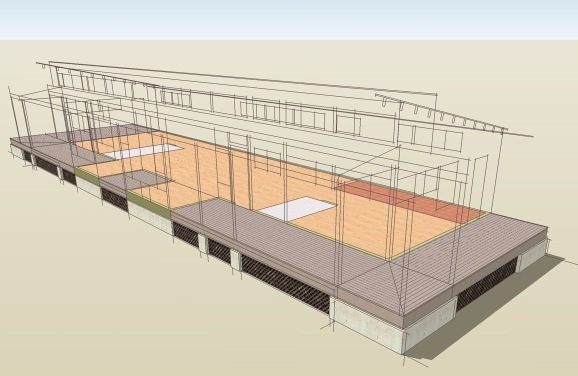 Here the model is now under way. The ground floor is modeled up, all but the steps from the deck, and the drawing template for the elevations is visible.
Here the model is now under way. The ground floor is modeled up, all but the steps from the deck, and the drawing template for the elevations is visible.
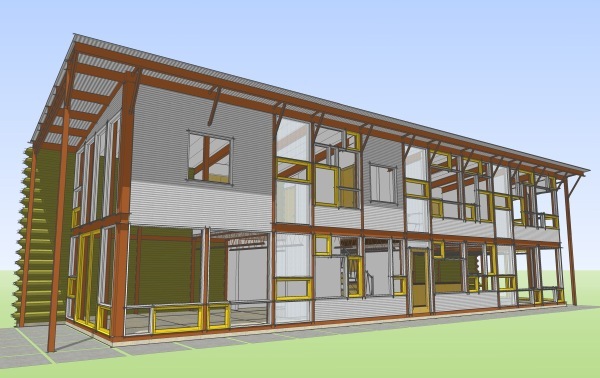 There are just a few items that I need to revise and the model will be complete for generating the renderings. But more or less, there it is - the Steel Case House in its new all metal clothes! I have decided to show the overhang braces in this version as they will be required almost anywhere that has any snow load. I am quite pleased with the transformation and what light it sheds on the design. One of the goals of my own design brief for these stock plans is to create house designs that can stand up to personalization, execution in a variety of materials without losing their integrity. I think this redressing speaks to that. The
There are just a few items that I need to revise and the model will be complete for generating the renderings. But more or less, there it is - the Steel Case House in its new all metal clothes! I have decided to show the overhang braces in this version as they will be required almost anywhere that has any snow load. I am quite pleased with the transformation and what light it sheds on the design. One of the goals of my own design brief for these stock plans is to create house designs that can stand up to personalization, execution in a variety of materials without losing their integrity. I think this redressing speaks to that. The 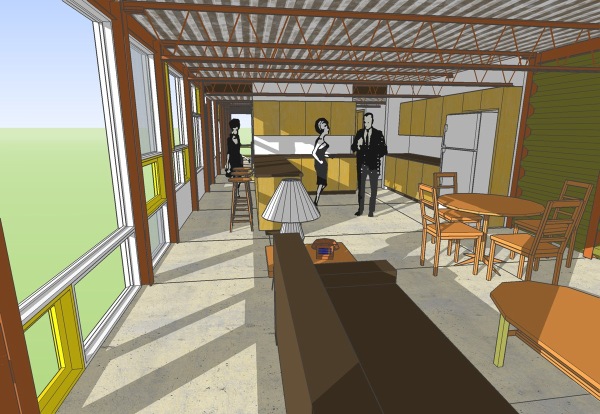 This is a direct comparison for the
This is a direct comparison for the 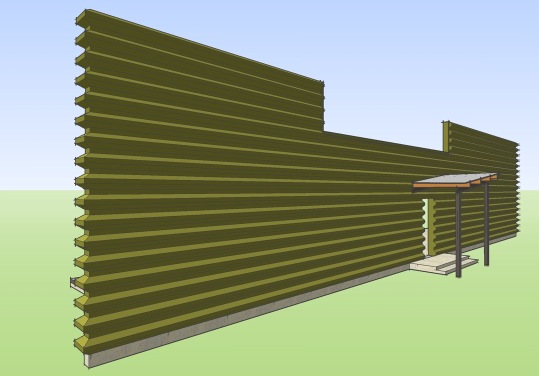 I think you can get a good sense here of the character of the deep rib siding, and the large scale of it in relationship to the wall. Its the scale of the siding that allows it to be a substitute for the solidness of the masonry wall in the original design.
I think you can get a good sense here of the character of the deep rib siding, and the large scale of it in relationship to the wall. Its the scale of the siding that allows it to be a substitute for the solidness of the masonry wall in the original design. 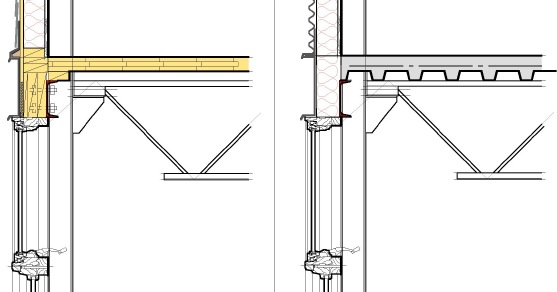 This time a portion of the wall section, showing the transformation from wood products to steel products.
This time a portion of the wall section, showing the transformation from wood products to steel products.
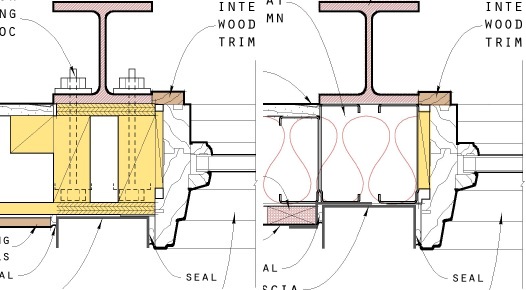 On the right in the new version we are dispensing with all things wood. Light gauge steel studs go directly over the structural steel frame, there is no plywood - corrugated metal siding is attached directly to the studs, and the strength of the siding takes the place of the plywood
On the right in the new version we are dispensing with all things wood. Light gauge steel studs go directly over the structural steel frame, there is no plywood - corrugated metal siding is attached directly to the studs, and the strength of the siding takes the place of the plywood
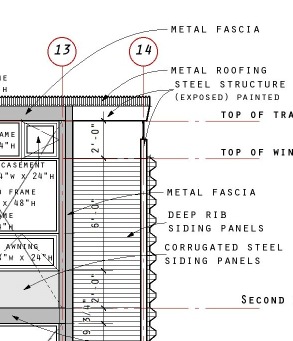 more info on this, and the other mods, yes there is more than one, will come as the renderings are prepared.
more info on this, and the other mods, yes there is more than one, will come as the renderings are prepared.


